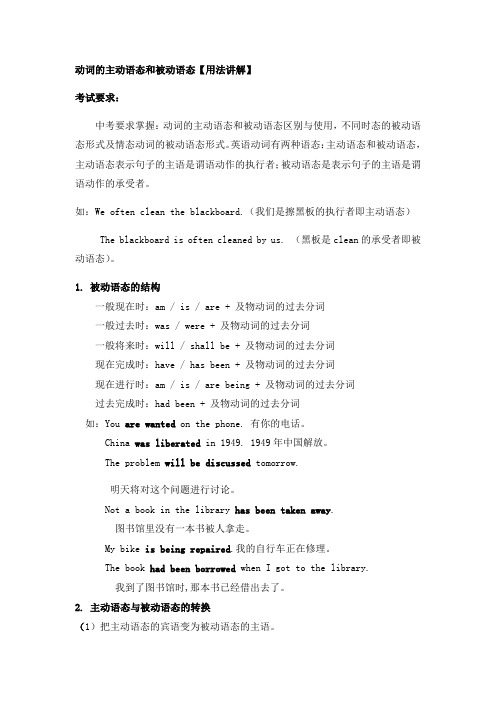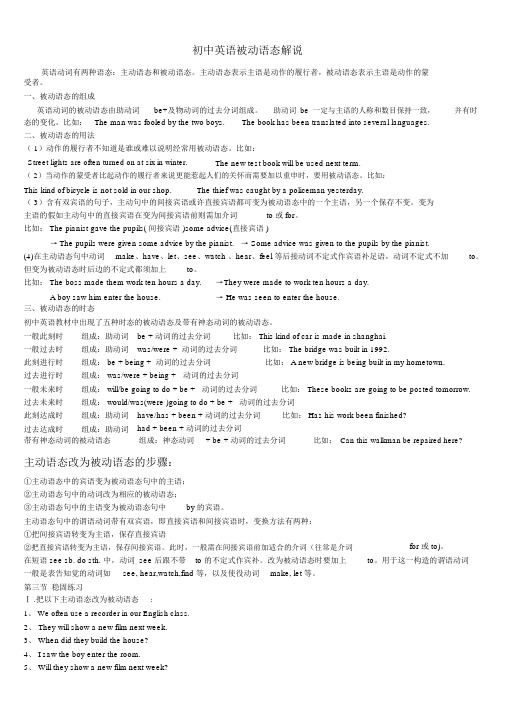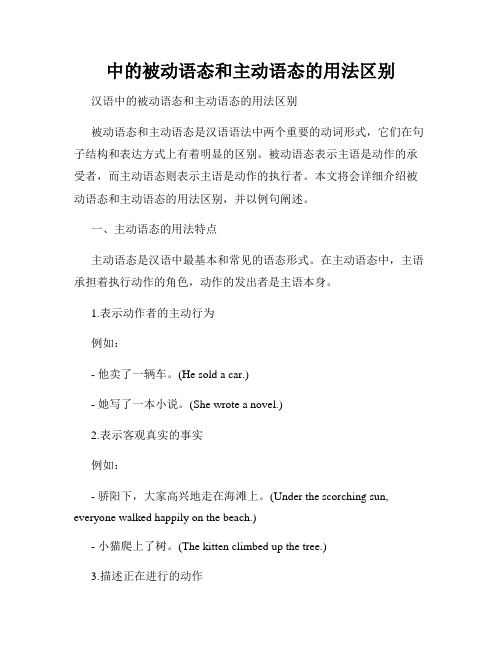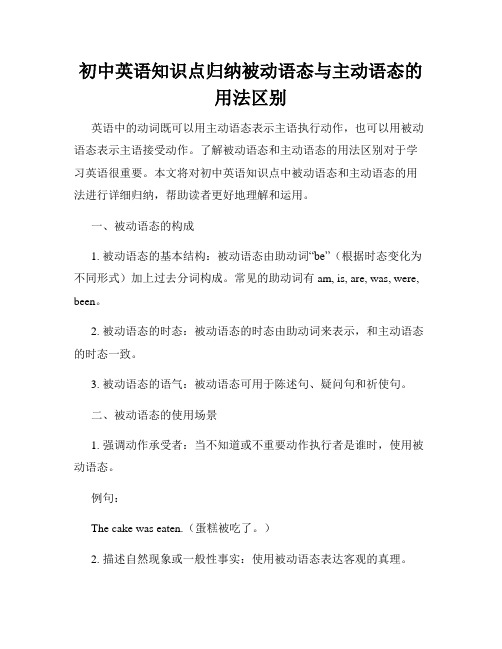初中主动语态与被动语态讲解
初中英语语态知识点总结

初中英语语态知识点总结一、语态基本概念语态是英语语法中的一个重要组成部分,它决定了句子中动作的执行者和承受者。
英语中主要有两种语态:主动语态(Active Voice)和被动语态(Passive Voice)。
1. 主动语态:主动语态是最常见的语态形式,其结构为“主语 + 动词 + 其他”,主语是动作的执行者。
例如:Tom writes a letter.(汤姆写了一封信。
)2. 被动语态:被动语态的结构为“主语 + be动词 + 过去分词 + 其他”,主语是动作的承受者。
例如:A letter is written by Tom.(一封信被汤姆写了。
)二、被动语态的构成被动语态的构成是初中英语教学的重点,其基本形式为“主语 + be + 过去分词 + (by + 动作执行者)”。
根据不同的时态和情况,被动语态会有所变化。
1. 一般现在时的被动语态:am/is/are + 过去分词。
例如:The book is written by the author.(这本书是由作者写的。
)2. 一般过去时的被动语态:was/were + 过去分词。
例如:Theletter was sent by him.(这封信是他发送的。
)3. 一般将来时的被动语态:will be + 过去分词。
例如:A newschool will be built soon.(一所新学校不久将会被建造。
)4. 现在进行时的被动语态:am/is/are being + 过去分词。
例如:The house is being painted.(房子正在被粉刷。
)5. 现在完成时的被动语态:has/have been + 过去分词。
例如:The work has been finished.(工作已经完成了。
)6. 过去完成时的被动语态:had been + 过去分词。
例如:The book had been published before he died.(他去世前这本书已经出版了。
被动语态与主动语态的区别

被动语态与主动语态的区别被动语态和主动语态是语法中两种表达方式,它们用于描述动作的执行者和承受者之间的关系。
被动语态强调动作的承受者,而主动语态则强调动作的执行者。
下面是被动语态和主动语态的区别:被动语态- 被动语态由两部分构成:助动词 "被" + 过去分词。
例如,“这个问题被妈妈解决了。
”- "被" 表示承受动作的角色。
- 过去分词表示动作的状态或完成情况。
- 被动语态中,主语通常是承受者,动作的执行者可以省略或放在介词 "由" 后面。
例如,“这个问题被妈妈解决了。
”或“这个问题由妈妈解决了。
”- 被动语态用于强调动作的承受者,而不关注动作的执行者。
主动语态- 主动语态是最常用的语态,在句子中表示主语执行动作。
例如,“妈妈解决了这个问题。
”- 主动语态中,主语是动作的执行者,动作的承受者可以省略或放在介词 "对" 后面。
例如,“妈妈解决了这个问题。
”或“妈妈对这个问题做出了解决。
”- 主动语态用于强调动作的执行者,而不关注动作的承受者。
区别总结总结被动语态与主动语态的区别如下:- 被动语态由助动词 "被" + 过去分词构成,主动语态不需要助动词。
- 被动语态强调动作的承受者,主动语态强调动作的执行者。
- 被动语态中,动作的执行者可以省略或放在介词 "由" 后面;主动语态中,动作的承受者可以省略或放在介词 "对" 后面。
了解被动语态和主动语态的区别有助于我们在写作和交流中选择合适的语态来表达我们的意思。
根据上述区别,我们可以根据需要选择使用被动语态或主动语态来传达我们想要表达的信息。
初中英语动词的主动语态和被动语态讲解

动词的主动语态和被动语态【用法讲解】考试要求:中考要求掌握:动词的主动语态和被动语态区别与使用,不同时态的被动语态形式及情态动词的被动语态形式。
英语动词有两种语态:主动语态和被动语态,主动语态表示句子的主语是谓语动作的执行者;被动语态是表示句子的主语是谓语动作的承受者。
如:We often clean the blackboard.(我们是擦黑板的执行者即主动语态)The blackboard is often cleaned by us. (黑板是clean的承受者即被动语态)。
1. 被动语态的结构一般现在时:am / is / are + 及物动词的过去分词一般过去时:was / were + 及物动词的过去分词一般将来时:will / shall be + 及物动词的过去分词现在完成时:have / has been + 及物动词的过去分词现在进行时:am / is / are being + 及物动词的过去分词过去完成时:had been + 及物动词的过去分词如:You are wanted on the phone. 有你的电话。
China was liberated in 1949. 1949年中国解放。
The problem will be discussed tomorrow.明天将对这个问题进行讨论。
Not a book in the library has been taken away.图书馆里没有一本书被人拿走。
My bike is being repaired.我的自行车正在修理。
The book had been borrowed when I got to the library.我到了图书馆时,那本书已经借出去了。
2. 主动语态与被动语态的转换(1)把主动语态的宾语变为被动语态的主语。
(2)把谓语变成被动结构(be+过去分词),根据被动语态句子里主语的人称和数,以及原来主动语态句子中动词的时态来决定be的形式。
动词的被动语态和主动语态的区别

动词的被动语态和主动语态的区别动词的被动语态和主动语态是语法学中的重要概念,它们在句子结构和意义上有着明显的区别。
被动语态表示主动词所指动作的承受者是谁,而主动语态则强调主题是动作的执行者。
本文将探讨被动语态和主动语态的区别,并举例解释其用法和影响。
1. 句子结构上的区别被动语态的句子结构为:被动化助动词(am, is, are, was, were等)+ 动词的过去分词形式。
例如:The book was written by him.(这本书是他写的。
)主动语态的句子结构为:主语 + 动词 + 宾语。
例如:He wrote the book.(他写了这本书。
)2. 执行者与承受者的区别在被动语态中,主动词的执行者在句子中通常以介词“by”引出,并位于谓语动词之后的位置。
例如:The letter was sent by him.(这封信被他寄出。
)在主动语态中,主语充当动作的执行者。
例如:He sent the letter.(他寄了这封信。
)3. 语义上的区别被动语态强调动作的承受者,而主动语态则强调动作的执行者。
被动语态通常用于以下情况:a. 执行者未知或无需强调。
例如:The car was repaired yesterday.(这辆车昨天被修理了。
)b. 强调动作的结果或状态。
例如:The book is written in French.(这本书是用法语写的。
)主动语态通常用于以下情况:a. 表达主观意愿或意图。
例如:I will write a letter to my friend.(我将给我的朋友写一封信。
)b. 强调执行者的动作。
例如:The teacher explains the lesson clearly.(老师清楚地解释了这节课。
)4. 语气和语态的转换被动语态可以通过添加情态动词或助动词来转换为相应的时态和语态。
例如:a. He should be invited to the party.(他应该被邀请参加派对。
(完整)初中英语被动语态讲解

初中英语被动语态解说英语动词有两种语态:主动语态和被动语态。
主动语态表示主语是动作的履行者,被动语态表示主语是动作的蒙受者。
一、被动语态的组成英语动词的被动语态由助动词be+及物动词的过去分词组成。
助动词be一定与主语的人称和数目保持一致,态的变化。
比如:The man was fooled by the two boys.The book has been translated into several languages.二、被动语态的用法( 1)动作的履行者不知道是谁或难以说明经常用被动语态。
比如:并有时Street lights are often turned on at six in winter.The new test book will be used next term.( 2)当动作的蒙受者比起动作的履行者来说更能惹起人们的关怀而需要加以重申时,要用被动语态。
比如:This kind of bicycle is not sold in our shop.The thief was caught by a policeman yesterday.( 3)含有双宾语的句子,主动句中的间接宾语或许直接宾语都可变为被动语态中的一个主语,另一个保存不变。
变为主语的假如主动句中的直接宾语在变为间接宾语前则需加介词to 或 for。
比如: The pianist gave the pupils( 间接宾语 )some advice(直接宾语 )→The pupils were given some advice by the pianist. → Some advice was given to the pupils by the pianist.(4)在主动语态句中动词make、have、let、see、watch 、hear、feel 等后接动词不定式作宾语补足语,动词不定式不加to。
中的被动语态和主动语态的用法区别

中的被动语态和主动语态的用法区别汉语中的被动语态和主动语态的用法区别被动语态和主动语态是汉语语法中两个重要的动词形式,它们在句子结构和表达方式上有着明显的区别。
被动语态表示主语是动作的承受者,而主动语态则表示主语是动作的执行者。
本文将会详细介绍被动语态和主动语态的用法区别,并以例句阐述。
一、主动语态的用法特点主动语态是汉语中最基本和常见的语态形式。
在主动语态中,主语承担着执行动作的角色,动作的发出者是主语本身。
1.表示动作者的主动行为例如:- 他卖了一辆车。
(He sold a car.)- 她写了一本小说。
(She wrote a novel.)2.表示客观真实的事实例如:- 骄阳下,大家高兴地走在海滩上。
(Under the scorching sun, everyone walked happily on the beach.)- 小猫爬上了树。
(The kitten climbed up the tree.)3.描述正在进行的动作例如:- 她正在吃饭。
(She is eating.)- 他们在商量计划。
(They are discussing the plan.)4.表示意愿、建议、请求等语气例如:- 你可以来帮我一下吗?(Can you come and help me?)- 我建议买这款手机。
(I suggest buying this phone.)二、被动语态的用法特点被动语态是指在句子中将动作的承受者置于主语的位置,突出了动作的接受者和受影响程度。
1.动作的接受者置于主语位置例如:- 这个电影被观众们欣赏。
(This movie is appreciated by the audience.) - 邮件被邮递员送到了。
(The mails have been delivered by the mailman.)2.动词前面加“被”字例如:- 我们的计划被取消了。
(Our plan has been canceled.)- 这个问题被他解决了。
初中英语知识点归纳被动语态与主动语态的用法区别

初中英语知识点归纳被动语态与主动语态的用法区别英语中的动词既可以用主动语态表示主语执行动作,也可以用被动语态表示主语接受动作。
了解被动语态和主动语态的用法区别对于学习英语很重要。
本文将对初中英语知识点中被动语态和主动语态的用法进行详细归纳,帮助读者更好地理解和运用。
一、被动语态的构成1. 被动语态的基本结构:被动语态由助动词“be”(根据时态变化为不同形式)加上过去分词构成。
常见的助动词有am, is, are, was, were, been。
2. 被动语态的时态:被动语态的时态由助动词来表示,和主动语态的时态一致。
3. 被动语态的语气:被动语态可用于陈述句、疑问句和祈使句。
二、被动语态的使用场景1. 强调动作承受者:当不知道或不重要动作执行者是谁时,使用被动语态。
例句:The cake was eaten.(蛋糕被吃了。
)2. 描述自然现象或一般性事实:使用被动语态表达客观的真理。
Water is boiled at 100 degrees Celsius.(水被煮沸时会达到100度。
)3. 表达经验、感受或意见:使用被动语态使句子更客观、客观。
例句:We were surprised by the news.(我们被这个消息惊到了。
)三、主动语态的构成1. 主动语态的基本结构:主动语态由主语执行动作,动作的执行者在句子中处于主语的位置。
2. 主动语态的时态:主动语态的时态由动词本身的时态来表达。
3. 主动语态的语气:主动语态可用于陈述句、疑问句和祈使句。
四、主动语态的使用场景1. 强调动作执行者:当需要强调动作的主体时,使用主动语态。
例句:The cat caught the mouse.(猫抓住了老鼠。
)2. 描述事件或行为:使用主动语态来表达主观意愿或目的。
例句:I will bake a cake for your birthday.(我会给你的生日做一个蛋糕。
)3. 表达感受或意见:使用主动语态使句子更主观、直接。
主动语态和被动语态

主动语态和被动语态
主动语态和被动语态是语法中的两种不同的句式结构,它们在句子
中的主语和谓语之间的关系不同。
在主动语态中,主语是动作的执行者,而被动语态中,主语是动作的承受者。
接下来我们将详细讨论主
动语态和被动语态的区别,以及它们在实际应用中的用法。
主动语态是指句子的主语执行动作的句式结构。
比如:“小明吃了
一个苹果。
”这个句子中,主语“小明”是动作的执行者,动词“吃”表示
了主语的动作。
主动语态通常用于强调动作的执行者,突出动作的主
动性。
相比之下,被动语态是指句子的主语是动作的承受者的句式结构。
比如:“这个苹果被小明吃了。
”这个句子中,主语“这个苹果”是动作“吃”的承受者,动词“吃”前面加上了“被”,表示了动作的被动性。
被动
语态通常用于强调动作的接受者,或者强调动作对主语的影响。
在实际应用中,主动语态和被动语态的选择取决于句子中的重点和
表达的方式。
如果要强调动作的执行者或者主语的主动性,就可以使
用主动语态;如果要强调动作的承受者或者主语的被动性,就可以使
用被动语态。
此外,被动语态还可以用于不知道执行动作的具体人物,或者为了避免指责或强调动作本身。
总的来说,主动语态和被动语态是语法中不可或缺的两种句式结构,它们在表达方式和语气上有不同的特点。
合理运用主动语态和被动语
态可以使句子更加丰富多彩,准确表达作者的意图。
希望通过本文的
讨论,读者对主动语态和被动语态有了更清晰的认识。
- 1、下载文档前请自行甄别文档内容的完整性,平台不提供额外的编辑、内容补充、找答案等附加服务。
- 2、"仅部分预览"的文档,不可在线预览部分如存在完整性等问题,可反馈申请退款(可完整预览的文档不适用该条件!)。
- 3、如文档侵犯您的权益,请联系客服反馈,我们会尽快为您处理(人工客服工作时间:9:00-18:30)。
主动语态与被动语态
一.概念:主动语态表示主语是动作的执行者,被动语态表示主语是动作的承受者。
二.被动语态的构成:助动词be+及物动词的过去分词
三.被动语态的时态:以为work 例:
1. 一般现在时: am / is/are+ worked
2. 一般过去时: was / were+ worked
3. 一般将来时: shall / will +be+ worked
4. 过去将来时: should / would+be+ worked
5. 现在进行时: am /is/are+ being+ worked
6. 过去进行时: was /were+ being+ worked
7. 现在完成时: have/has+ been+ worked
8. 过去完成时: had +been+ worked
9. 将来完成时: shall/ will +have been +worked
10. 过去将来完成时: should/would +have been+ worked
11. 情态动词(can/may/must/should etc.)+be+动词的过去分词
四.用法:当我们不知道谁是动作的执行者或者没有必要指出谁是动作
的执行者时或者只需强调动作的承受者时,要用被动语态。
五.方法:Many people speak English.(主动语态)
English is spoken by many people.(被动语态)
六. 注意以下问题:
A. 带有双宾语的动词变为被动语态时,可以把其中一个宾语变为被动语态的主语,若将直接宾语(sth.)变为主语,须根据习惯在原间接宾语前加上介词to或for
用to的常见词有:give, show, send, lend, pass, pay, teach, throw, take, bring etc.
用for的常见词有:make, choose, sing, play, draw, save, buy, get, leave, cook etc.
eg. 1. Mary gave him some books.
He was given some books by Mary.
Some books were given to him by Mary.
2. Her father bought her a new bike.
She was bought a new bike by her father.
A new bike was bought for her by her father.
B.带复合宾语(宾语+宾语补足语)的动词变为被动语态时,只能将宾语变为被动语态的主语,宾语补足语不可变为主语。
eg. 1. We call her Gina.
She is called Gina (by us).
2. They made me happy.
I was made happy( by them).
3. He asked me to come here.
I was asked to come here (by him)
C. 在see, let, make, hear, watch etc.动词之后,作宾语补足语的动词不定式不带to,但在变为被动语态时,则一定要加上to。
eg. 1. We saw them play football just now.
They were seen to play football just now.
2. We often hear her sing in English.
She is often heard to sing in English.
D. 在某些“不及物动词+介词/副词”(相当于及物物动词)的句子中,变被动语态时,注意不要丢掉介词/副词。
eg.
1. People often talk about that film.
That film is often talked about.
2. We should speak to the old people politely.
The old people should be spoken to politely.
E. 主动形式表示被动意义的词:
1)某些感官动词: look, smell, taste , feel, wear ,sound, etc.
2)某些及物动词+副词:wash, write, sell, read, open, cut, shut, keep, etc. 1. This coat feels soft.
2. The pen writes smoothly.
3. That book sells well.
4. This kind of shirt washes easily.
F. 只有及物动词(vt.)才有被动语态,不及物动词(vi.)没有被动语态,因为它不带宾语。
eg. happen
What was happened?×What has happened?√What is happening? √
G. 若主动句的主语是表示地点的名词,变为被动语态时,应将其变为in+名词,作地点状语,而不变为by的宾语。
eg. Our village opened a new school last year.
A new school was opened in our village last year.
H. 若主动句的谓语动词是know变为被动语态时,应将其变为be known to,而不能变为be known by。
eg. People all over the world know the Great Wall.
The Great Wall is known to people all over the world.
I. 若主动句的主语是nobody, no one等否定不定代词时,变为被动语态应将其anybody, anyone作介词by的宾语,并将其谓语动词改为否定的被动语态。
eg. Nobody can answer this question.
This question can not be answered by anybody.
一.句型转换:1. A large number of people speak French in Paris.
French ____ ______ ____a large number of people in Paris.
2. My cousin repaired the broken watch.
The broken watch ____ _____ _____my cousin.
3. We should plant the trees around the lake.
The trees _____ _____ ______around the lake.
4. My aunt gave me a present on my birthday.
I ____ _____a present by my aunt on my birthday.
A present _____ ____ _____me by my aunt on my birthday.。
